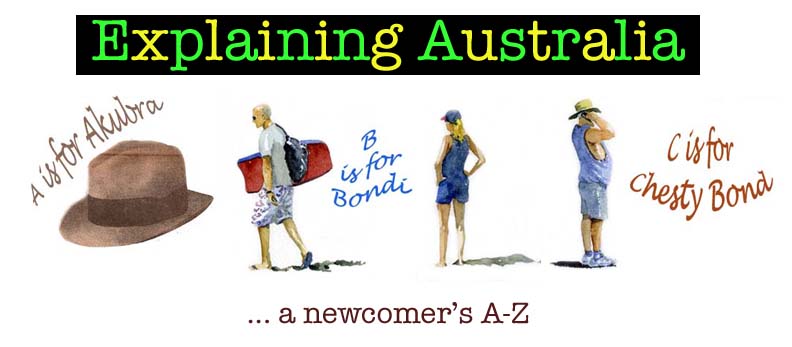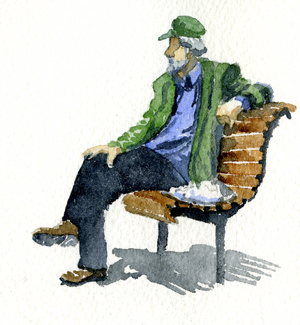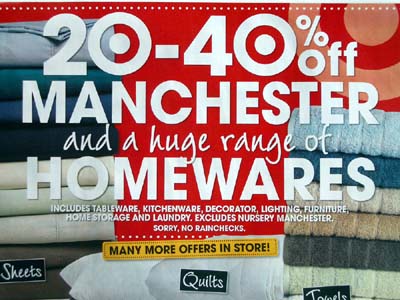
Text & artwork © Michael Kluckner, 2009
Contact me Return to home page
 |
 |
 |
 |
 |
I Immigration: People who decide they want to settle in Australia are attempting to immigrate at a curious time in the country’s history. With too few skilled workers and too many aging citizens, Australia has to attract new people from an increasingly competitive world market. Yet environmentally, with climate change positing longer, dryer, hotter weather and near-permanent droughts in some of Australia’s traditional breadbaskets, the country at 21 or 22 million is showing signs of being full up. It’s a far cry from the situation a half-century ago, when the slogan “Populate or Perish” reflected the thinly-settled country’s narrow escape from invasion during the Second World War. The aim then was to achieve a nation of 20 million people, so the doors were thrown open to Europeans wanting a new start, including the refugees displaced by the war. Two million “New Australians” had arrived by the mid-1960s, adding to the citizenry of seven million. As George Johnston wrote in 1965, the migration “had a shattering effect on Australia, forcing new values, new standards, new viewpoints, new maturities.” Casting off his xenophobic, bigoted mantle, the modern Australian was now “a more sympathetic figure than the Depression-haunted figure of the ‘thirties.” At least, it was a start. What had happened to the United States, Brazil and Argentina in the 19th century and to Canada at the beginning of the 20th finally came to Australia at mid-century. When I was growing up in Canada, I knew about the Flying Doctor service, kangaroos, koalas and the “White Australia” policy. It had its origins in the 1850s due to the influx of peoples from all over the world, especially Chinese miners, during the gold rush, and was such a popular aspect of government policy that generations later, in 1919, Prime Minister “Billy” Hughes described it as “the greatest thing we have achieved.” The outbreak of war with Japan caused Prime Minister John Curtin in 1942 to reinforce the policy, stating “this country shall remain forever the home of the descendants of those people who came here in peace in order to establish in the South Seas an outpost of the British race.” Change began after the war, paralleling developments in non-racial immigration policies in other “new world” nations. German traveller Bernd Lohse, who wrote in the 1950s that he was “going to the white man's bastion in the south of the seething Asiatic world,” noted that “there is awakening a mild discomfort in the thinly-populated continent which was proud for so long of its strict 'White Australia' policy. Australia today is trying to let this once sacred expression sink into disuse." In 1966, the official policy began to be dismantled, leading to colour-blind policies since the 1970s. Australia’s big cities now are as polyglot and multi-coloured as those in North America or Europe but the countryside still looks very Caucasian. In fact, 92 percent of the Australian population is still “white.” http://www.immi.gov.au/media/fact-sheets/08abolition.htm J Jaffas: from Elizabeth: Jaffas are my favourite Aussie lollies - like jaffa oranges from Israel, they are small round balls with a reddish orange exterior with dark "choccie" inside. On my last visit I could only find them in large bags Coles or Woolworths. As a kid I never knew why they were called Jaffas - weren't too many Jewish people in Longueville or my schools to enlighten me. From Christine: the "bad boys" at the movies would wait for a quiet scene and then drop a handful of jaffas onto the floor. They would roll noisily all the way down the inclined floor and whack against the edge of the stage. Jaffle: an almost-vanished sandwich type, once a standard at the milk bars and picnics of the nation. Recently, as the milk bars have also disappeared, the term is disappearing from the language. Australia's lunch shops have Italianised with calzones and paninis that are rarely as varied as the jaffles were. Like, have you ever seen a vegemite calzone on a cafe menu? Do you agree that a cultural touchstone has been lost? The jaffle iron was a device with long handles connected to hinged concave plates, either square or round; you built your sandwich on the opened plates, with a slice of bread butter-side down on each one, loading the interior with anything that suited your fancy, after which you clamped the iron shut to seal the edges. If it was a round iron, you would tear or cut off the bits of bread left hanging out and eat them, sustaining you while you waited for the jaffle to toast. (Note the use of the word "toast": it means grill. Bread is toasted too, but a toasted sandwich is not a cold sandwich made with toast instead of bread. Comprendé?) You then placed the iron on a stove element, gas flame, barbie or campfire until the jaffle was browned and the insides were all hot and melted and fantastic. There are also electric jaffle irons available. Jumper: not a kangaroo, as you might expect – that's a boomer – but a sweater, as in something you'd wear on a cold day. One of the many terms originating in England and common in Australia. K  Kiwi: a subspecies of homo australianus modernus living on the Long White Cloud, sometimes called New Zealand. Generally, Kiwis who want to swim in a bigger pond move to Australia, as ambitious Aussies move to the USA or England. Successful Kiwis, such as pop musicians Crowded House and actors Sam Neill and Russell Crowe, tend to get claimed by Australians as their own. The population of New Zealand, about 4 million, is less than the population of either Sydney or Melbourne. They have a slightly different accent. Kokoda Track: the second offshore sacred site – the first being Gallipoli. It’s in Papua New Guinea, a trail across the mountains that the ANZACs used during WWII to harass and destabilise the occupying Japanese army. Kylie: a distinctively Australian girl's name, not just because of the most famous of the Kylies, the Minogue one. Other distinctive Aussie girls' names are Rae-Wynn and Raelene. For boys, it's hard to think of a distinctive name except possibly Kyle or Kerry. Then there's Blue, but that's a nickname for redheaded boys. From Elizabeth: blue was also used for red headed girls - I was called "blue" as a kid by my uncle in Tamworth. Another example of a name reversing letters I came across here was an Aussie nurse named EVOL [love spelled backwards – what were her parents thinking – it's too awful] L Larrikin: like a hoon, except more blokey, friendly and probably older – and without the connotations of illegality. Some say that a justification for the larrikinism of Australians is resistance to the huge numbers of rules and laws produced by the government and all its agencies, which might be a leftover from the paternalistic society of the convict era, or might just be a few generations of bureaucrats and lawyers fulfilling their life roles. Regardless, Australia has world-class rules, world-class bureaucracy that gives new meaning to the word “Byzantine.” One of the early literary characters that sent an image of larrikinism around the world was Joe Harman, the “ringer” aka stockman in Neville Shute’s 1950 story “A Town Like Alice.” Smitten by the pretty young Jean Paget in wartime Malaya, Harman stole several of the Japanese commandant’s prize chickens to feed her beleaguered group of captive British women and children. His defiant, devil-may-care attitude when caught gets him crucified and bashed. The commandant asks him whether there’s anything he wants before he succumbs from his wounds. Ever defiant, the classic larrikin, Harman rasps, “You bloody bastard. I’ll have one of your black chickens and a bottle of beer.” A generation later, “Bazza“ McKenzie redefined the larrikin for the international art-cinema audience as a colonial yobbo visiting sophisticated London. The 1972 film “The Adventures of Barry McKenzie,” based on a character by Barry Humphries, became a classic of “New Wave” Aussie cinema. M |
Mad Max:
a documentary of life in the Australian Outback. Manchester: an all-encompassing word for sheets, towels, tablecloths, tea towels. Map of Tasmania: a woman's patch of pubic hair. Who thought that one up? Mate: if you're male, your mate is your friend, your buddy, the person you'd trust to help you out no matter what. However, you can feel you're anybody's mate in modern Australia. "Thanks, mate," often accompanied by "no worries," is a typical ending to a conversation or transaction with a stranger. Australians are very direct, but they often moderate their assertiveness by adding "mate" either to the beginning or end of a statement. Thus, "Mate, that's the stupidest bloody thing anybody could've done" cools the temperature of what might otherwise be a stoush-provoking statement. "You can get away with saying almost anything in Australia as long as you add 'mate' to the end" – Sarah Jane, who moved to Australia in the ‘90s. In the country towns, women will call either men or other women "mate," too. “Mate” is one of those words, like the “eh?” that Canadians are said to end sentences with, whose use diminishes the closer you get to the centre of a city. Milk Bar: once upon a time a landmark of every NSW and Victorian shopping street and country town. They fit in the same cultural niche as the old soda fountains of the USA a generation or two ago. A rougher version of a tea room to be sure: coffee, milkshakes, cokes, burgers, chips, jaffles, salad sandwiches on white bread, a fan turning lazily on the ceiling, colourful plastic strips in the opened doorway to try to keep the flies outside, a refrigerator for milk and pop, a freezer for Streets ice creams and paddle-pops, Cherry Ripe and Violet Crumble chocolate bars and lollies such as Jaffas for sale on the counter, a few tables or booths, sometimes a jukebox… Gradually wiped out by the more car-oriented culture of the last generation and the invasion of foreign burger chains and "handi-marts" attached to petrol stations. From Glenis in Florida: I lived in Narrabeen in a modest house overlooking the ocean. Our world was a glorious colourful one surrounded by the magnificent dark blue ocean and spent many happy years at the beach and finishing the day at the milk bar. Our favourite beach was Collaroy. |
 |
 |
 |
 |
 |
Contact me Return to home page